Alabama’s diverse ecosystems are home to many owl species, captivating observers with their silent flights and mesmerizing hoots.
Within the state’s woodlands, wetlands, and urban areas, seven distinct species of owls thrive, each contributing to the ecosystem’s delicate balance.
From the powerful Great Horned Owl to the elusive Eastern Screech Owl, these birds of prey play vital roles in controlling insect and rodent populations.
In this exploration, we delve into the unique characteristics, habitats, and conservation needs of the seven owl species inhabiting Alabama, shedding light on the importance of preserving these majestic nocturnal hunters for the ecological well-being of the state.
Join us on a journey through Alabama’s night skies as we unveil the enchanting world of its diverse owl population. Stay focused.
7 Owls in Alabama
Discover the enchanting world of owls in Alabama, where diverse habitats host a fascinating array of these nocturnal predators.
From the powerful Great Horned Owl to the elusive Flammulated Owl, each species brings unique characteristics and plays a crucial role in maintaining the ecological balance of this southern state.
1. Great Horned Owl
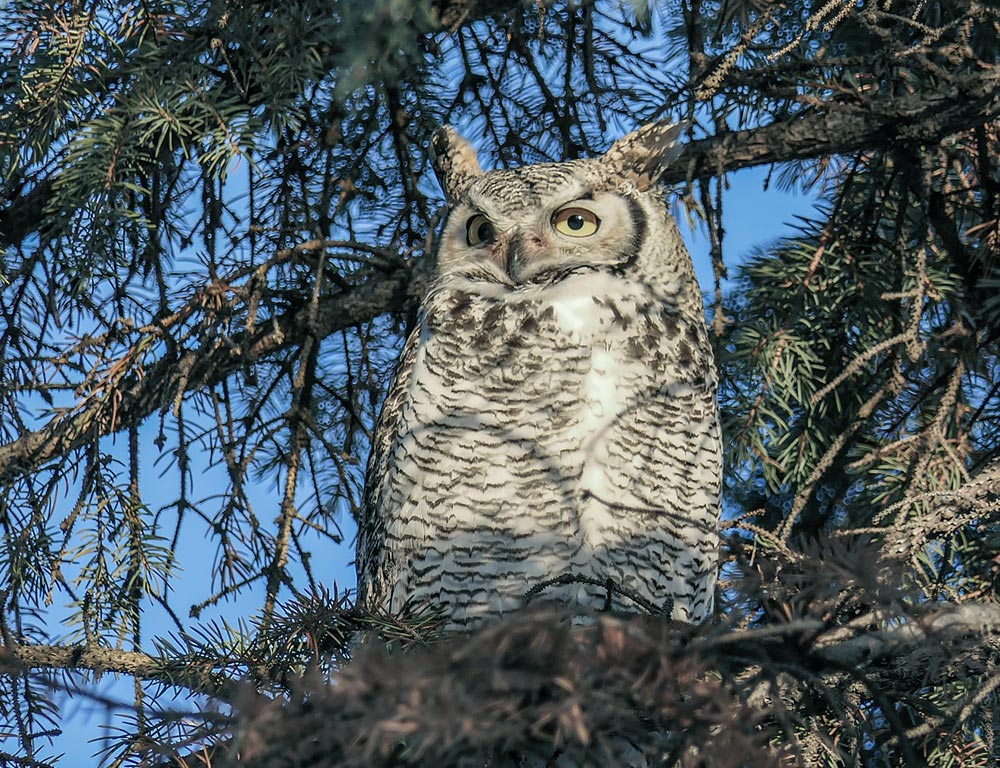
- Scientific Name: Bubo virginianus
- Category: Bird of Prey
- Population: Common and widespread
- Life Span: 5 to 15 years
- Size: 18 to 25 inches
- Weight: 2 to 5.5 pounds
- Food: Varied diet including mammals, birds, and reptiles
- Wingspan: 3.3 to 4.8 feet
- Status: Least Concern
The Great Horned Owl, a formidable raptor, thrives in various habitats across Alabama. With its striking ear tufts and piercing yellow eyes, it dominates the nocturnal skies.
Great Horned Owls exhibit a diverse diet, preying on small mammals like rabbits and rodents, as well as birds, reptiles, and even other owls. Known for their adaptability, they occupy both urban and rural environments.
These owls are skilled hunters, using their silent flight to surprise and capture prey. They nest in various locations, from abandoned nests to tree hollows. Great Horned Owls are committed parents, fiercely protecting their nests.
Their haunting hoots resonate through the night, establishing their territorial presence. With a significant population and adaptability, they play a crucial role in controlling rodent populations, contributing to the ecosystem’s balance.
2. Barred Owl
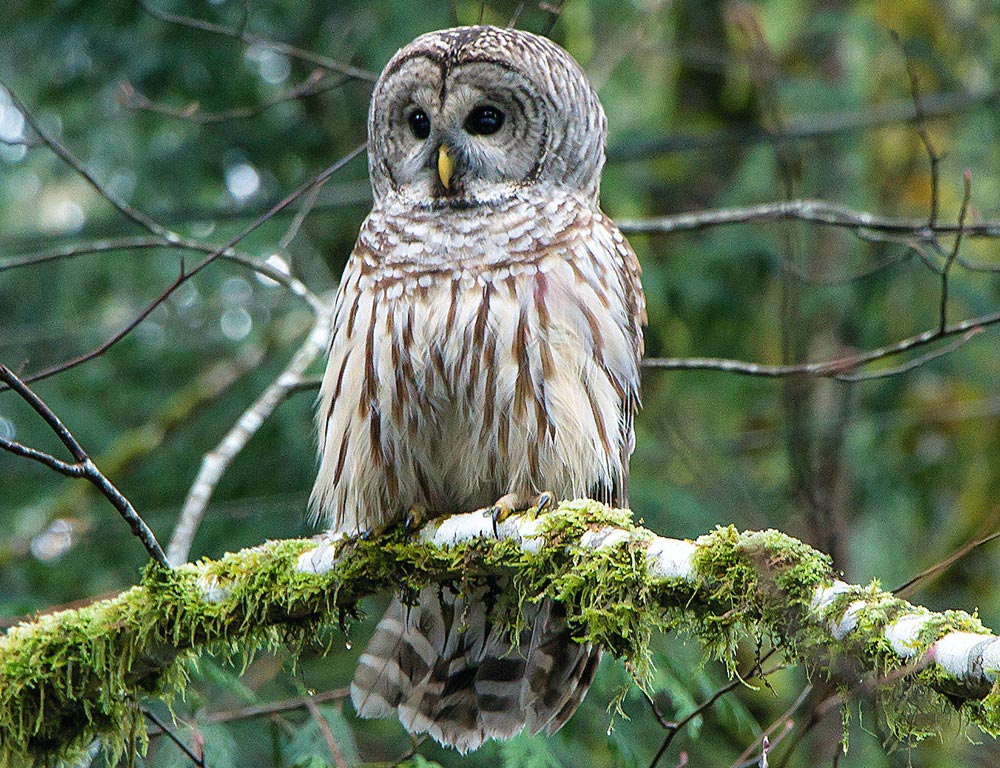
- Scientific Name: Strix varia
- Category: Bird of Prey
- Population: Stable
- Life Span: 10 to 23 years
- Size: 16 to 25 inches
- Weight: 1 to 2.5 pounds
- Food: Small mammals, birds, amphibians
- Wingspan: 3.3 to 3.8 feet
- Status: Least Concern
With its distinctive hooting call, the Barred Owl is a charismatic owl species found in Alabama’s woodlands and forests.
Adapted to a nocturnal lifestyle, these medium-sized owls primarily feed on small mammals like mice and squirrels. Their versatile diet includes birds, amphibians, and invertebrates.
Barred Owls are skilled hunters, using their excellent low-light vision and acute hearing to locate prey. They are territorial and maintain stable populations, often residing in mature forests near water bodies.
Their preferred nesting sites include tree hollows or abandoned nests, and they exhibit strong family bonds, with both parents actively caring for their offspring.
Despite some competition with other owl species, Barred Owls are well-adapted to their environment and contribute to the ecological balance by controlling small mammal populations.
3. Short-eared Owl
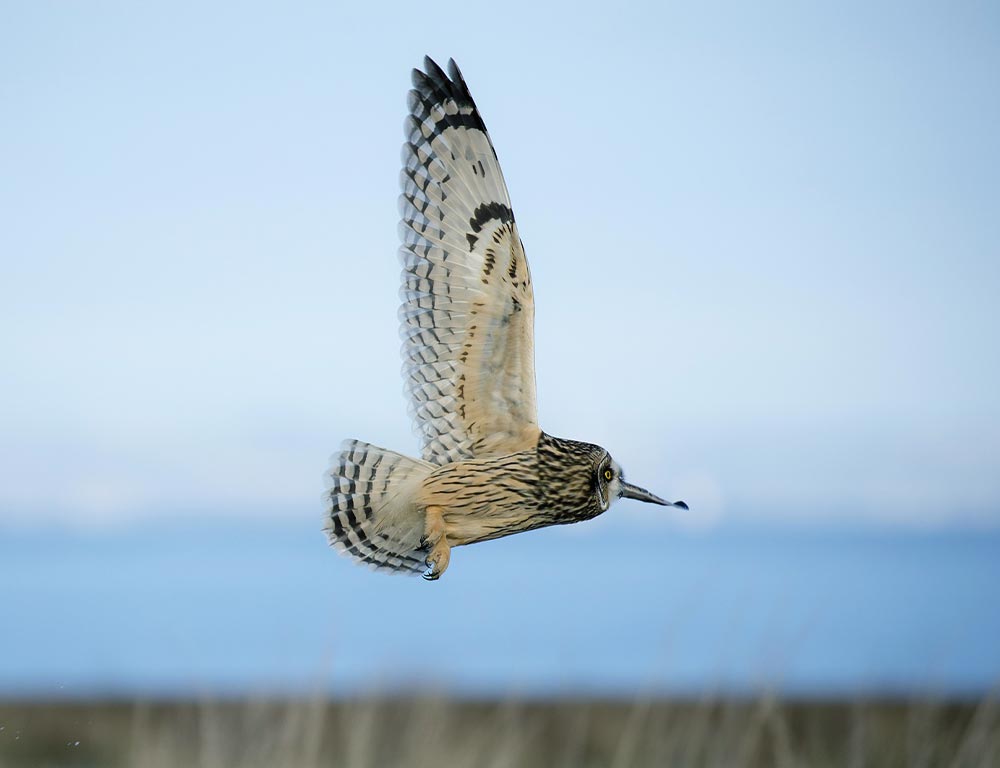
- Scientific Name: Asio flammeus
- Category: Bird of Prey
- Population: Declining
- Life Span: 3 to 5 years
- Size: 13 to 17 inches
- Weight: 7 to 17 ounces
- Food: Small mammals, birds, insects
- Wingspan: 2.9 to 3.9 feet
- Status: Near Threatened
The Short-eared Owl, recognized by its distinctive facial disc and short tufts, faces challenges in Alabama due to a declining population.
Found in open habitats like grasslands and marshes, these owls primarily feed on small mammals, birds, and insects.
Short-eared Owls are crepuscular and active during dawn and dusk. They are known for their erratic flight patterns and impressive hovering skills while hunting.
Habitat loss and changes in land use have contributed to their decline, making conservation efforts crucial.
Efforts to preserve open habitats and raise awareness about their importance in the ecosystem are vital for the Short-eared Owl’s survival.
Collaborative conservation initiatives can help protect this unique species and ensure a balanced environment in Alabama.
4. Eastern Screech Owl
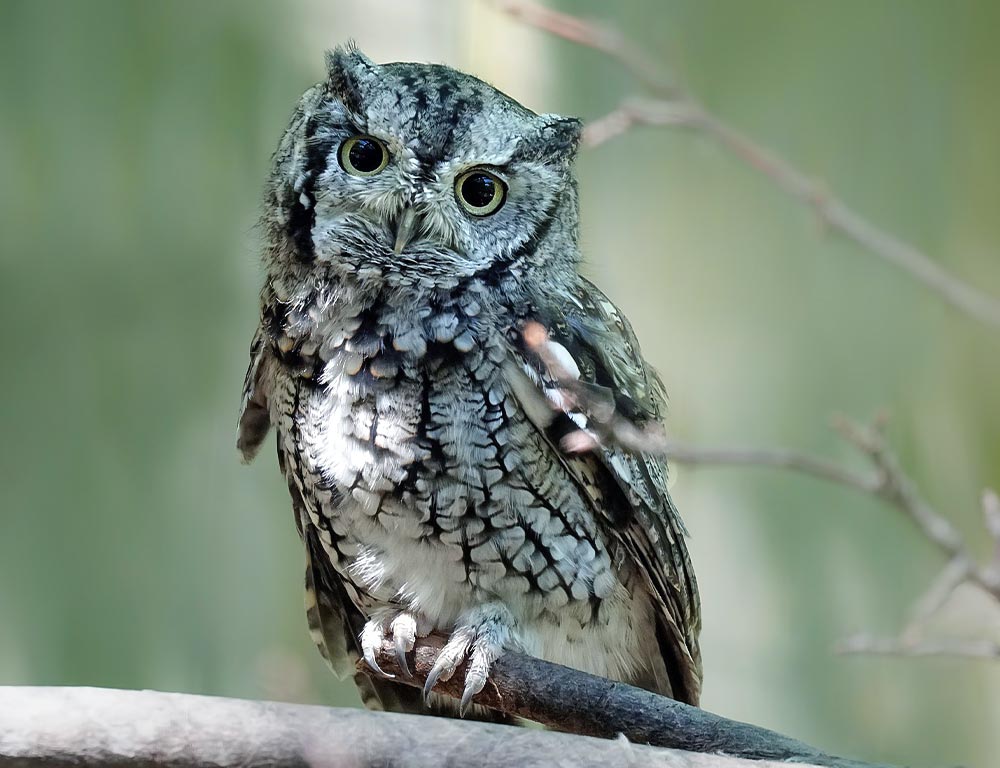
- Scientific Name: Megascops asio
- Category: Bird of Prey
- Population: Stable
- Life Span: 9 to 10 years
- Size: 6 to 10 inches
- Weight: 4 to 8 ounces
- Food: Insects, small mammals, birds
- Wingspan: 18 to 24 inches
- Status: Least Concern
The Eastern Screech Owl, with its distinctive ear tufts and camouflage plumage, is a small owl species thriving in various habitats across Alabama.
These nocturnal hunters primarily feed on insects, small mammals, and birds. They are adaptable and often found in wooded areas, parks, and suburban environments.
Eastern Screech Owls are cavity nesters, utilizing tree hollows or man-made nest boxes. They have a remarkable ability to blend into their surroundings, making them elusive to predators.
Their haunting trill and whinny calls are common sounds at night, contributing to the rich nocturnal soundscape of their habitats.
Despite their small size, Eastern Screech Owls are vital in controlling insect and small mammal populations, making them essential components of Alabama’s ecosystems.
5. Northern Saw-Whet Owl
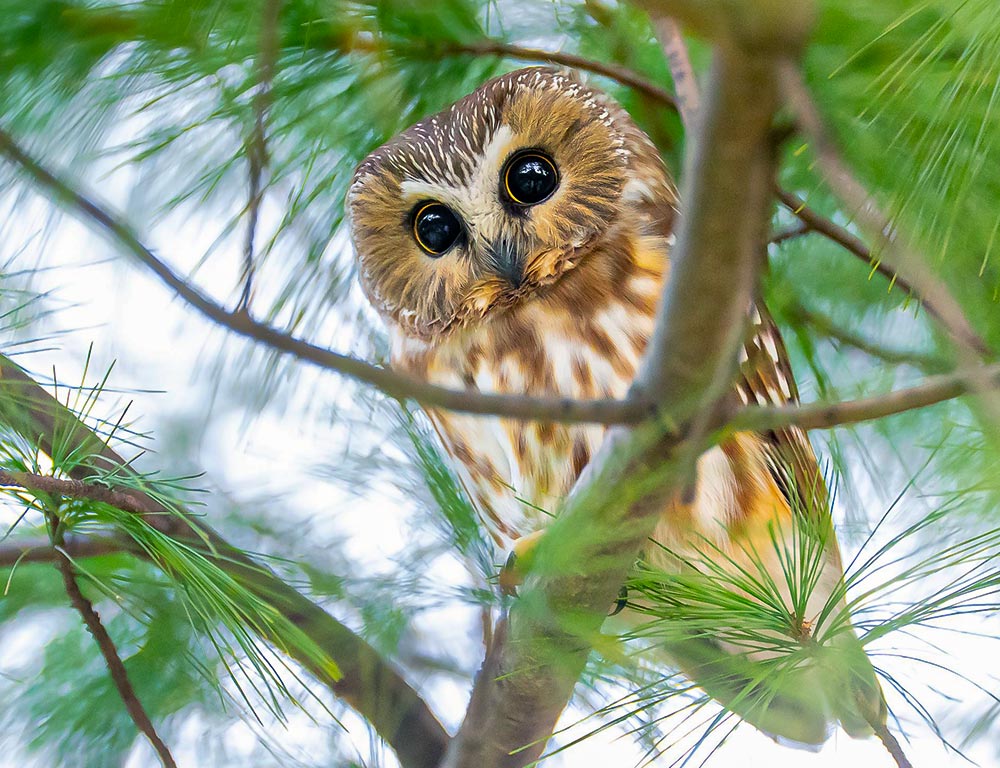
- Scientific Name: Aegolius acadicus
- Category: Bird of Prey
- Population: Stable
- Life Span: 7 to 8 years
- Size: 7 to 8 inches
- Weight: 2.5 to 5 ounces
- Food: Small mammals, birds, insects
- Wingspan: 16 to 18 inches
- Status: Least Concern
The Northern Saw-Whet Owl, named for its repetitive whistling call resembling a saw being sharpened, is a small and secretive owl species in Alabama.
Found in coniferous and mixed forests, they primarily prey on small mammals, birds, and insects.
These owls are efficient hunters, using their keen hearing and vision to locate prey. They nest in tree cavities or use abandoned nests, and their populations remain stable.
Although they are seldom seen due to their secretive nature, their presence contributes to the ecological balance by controlling small mammal and insect populations.
6. Flammulated Owl

- Scientific Name: Psiloscops flammeolus
- Category: Bird of Prey
- Population: Declining
- Life Span: 5 to 7 years
- Size: 6 to 7 inches
- Weight: 1.5 to 2.5 ounces
- Food: Insects, spiders
- Wingspan: 16 to 18 inches
- Status: Near Threatened
The Flammulated Owl, known for its small size and flame-colored markings, faces challenges with a declining population. Inhabiting ponderosa pine and mixed coniferous forests, these owls feed primarily on insects and spiders.
Their nocturnal lifestyle and reliance on specific habitats make them susceptible to habitat loss and changes in forest ecosystems.
Conservation efforts are crucial to protecting their nesting sites and preserving suitable environments to ensure the survival of the Flammulated Owl in Alabama.
7. Barn Owl
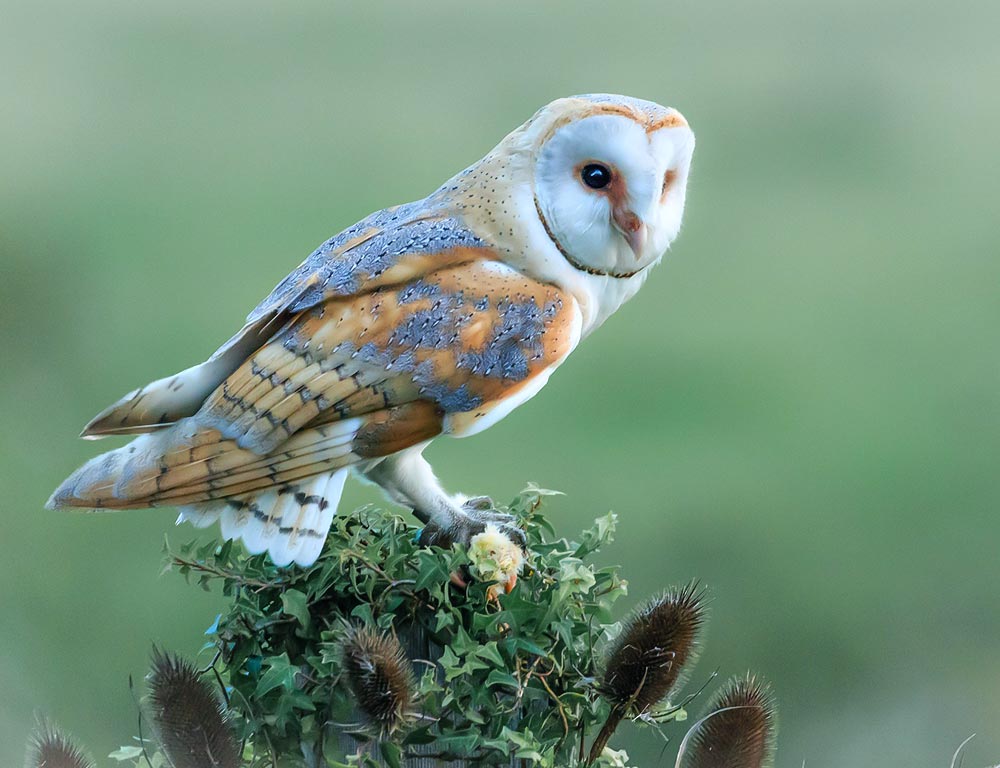
- Scientific Name: Tyto alba
- Category: Bird of Prey
- Population: Stable
- Life Span: 2 to 4 years
- Size: 12 to 15 inches
- Weight: 14 to 24 ounces
- Food: Small mammals, birds
- Wingspan: 39 to 49 inches
- Status: Least Concern
With its distinctive heart-shaped face, the Barn Owl is a common and widespread owl species in Alabama.
Found in various habitats, from farmlands to urban areas, these nocturnal hunters feed predominantly on small mammals and birds.
Barn Owls are efficient rodent controllers, making them valuable to agriculture. They nest in barns, hollow trees, and other structures, showcasing their adaptability to human-altered landscapes.
Despite their silent flight and elusive nature, their haunting screeches and hisses contribute to the nighttime soundscape of their habitats. With a stable population, the Barn Owl remains an important part of Alabama’s ecosystems.
Where to Spot Owls in Alabama?
Embark on an owl-watching adventure in the heart of Alabama, where diverse landscapes offer a haven for these captivating nocturnal creatures.
From dense woodlands to open fields, discover the prime locations to spot owls and witness their mesmerizing behaviors.
Wooded Areas
Explore the rich biodiversity of Alabama’s wooded regions, including state parks and nature reserves, where species like the Eastern Screech Owl and Barred Owl thrive amidst the trees.
Wetlands and Marshes
Head to wetland areas and marshes, especially during the breeding season, to catch glimpses of owls like the Short-eared Owl, adapting to life in these unique ecosystems.
Farmlands and Fields
Venture into farmlands and open fields, where Barn Owls gracefully hunt for rodents. Their preference for agricultural areas makes them a common sight, contributing to pest control.
Coniferous Forests
Explore coniferous and mixed forests for encounters with the Northern Saw-Whet Owl, particularly during the breeding season when these elusive owls become more active.
Urban Parks and Gardens
Surprisingly, even urban environments host owls. Visit city parks and gardens, where adaptable species like the Great Horned Owl have learned to coexist with human populations.
Conservation Areas
Support local conservation efforts and visit protected areas, ensuring the preservation of habitats for owls like the Flammulated Owl, which faces challenges with declining populations. Engage in responsible owl-watching to contribute to their conservation.
How to Preserve Owls in Alabama?
Preserving owls in Alabama requires a combination of conservation efforts and community involvement.
Here are some of the key strategies to ensure the well-being and sustainability of owl populations:
Habitat Conservation
Preserve and protect diverse habitats, including woodlands, wetlands, and grasslands, to maintain suitable environments for various owl species.
Support afforestation initiatives to counteract habitat loss and create additional nesting and foraging spaces.
Awareness and Education
Conduct educational programs and workshops to raise awareness about the importance of owls in the ecosystem and the threats they face.
Encourage the public to report owl sightings and participate in citizen science projects to contribute valuable data on owl populations.
Responsible Land Use
Promote and adopt sustainable agricultural practices to minimize the use of harmful pesticides and provide owls with a healthy prey base.
Incorporate owl-friendly features into urban planning, such as green spaces and wildlife corridors, to accommodate owls in urban environments.
Nest Box Programs
Implement nest box programs to provide alternative nesting sites, especially in areas with scarce natural tree hollows.
Regularly monitor and maintain nest boxes to ensure their effectiveness and address any issues promptly.
Mitigating Threats
Advocate for measures to reduce owl collisions with vehicles and structures, especially in areas with high owl populations.
Manage and control invasive species that may negatively impact owl habitats and prey populations.
Support Conservation Organizations
Support local and national conservation organizations working towards owl preservation through donations and volunteer efforts.
Collaborate with governmental agencies, NGOs, and private entities to form partnerships for comprehensive and sustained conservation initiatives.
Legislation and Policy Advocacy
Advocate for and support legislation that protects owls and their habitats, ensuring that conservation efforts are legally reinforced.
Participate in developing policies considering owl conservation in land management and development plans.
By implementing these strategies, individuals, communities, and organizations can play a crucial role in preserving owls in Alabama and contribute to the overall health and diversity of the state’s ecosystems.
Wrapping Up
In the enchanting realm of Alabama’s diverse landscapes, preserving owls is a shared responsibility.
We can secure the future of these captivating nocturnal hunters through habitat conservation, community engagement, and thoughtful initiatives.
By fostering coexistence, raising awareness, and supporting conservation programs, we contribute to the intricate tapestry of our natural world.
Let the haunting calls of owls in Alabama echo through protected woodlands, thriving wetlands, and even urban spaces, signaling a harmonious balance between humanity and the magnificent owls that grace our skies. Thank you so much.